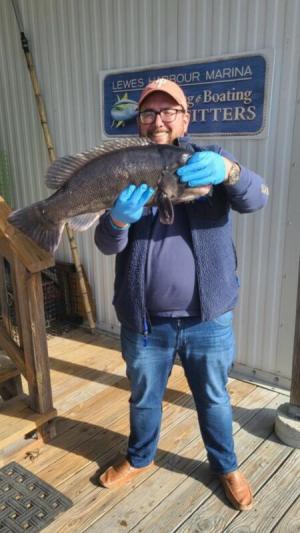I have been fishing Indian River Inlet since I was a young boy and it had a steel bulkhead instead of rocks, so you might think I would be an expert by now. Boy, would you be wrong. If anyone says they are an expert at fishing the rocks at the inlet, whatever you do, don’t by a used car from them. The only one I know who enjoys consistent success there is Capt. Aaron Herd on the Gale Force, and he fishes from a boat.
Tog fishing the rocks at the inlet requires special tackle. First, you should tie up your own rigs. I use 30-pound Hi Seas monofilament line beginning with an 18-inch length that I tie a perfection loop on one end and a double surgeon’s loop on the other. In between the two and closer to the bottom loop, I tie either another double surgeon’s loop or a dropper loop. The perfection loop connects the rig to the main line via a snap. The surgeon’s loop on the bottom is used to hold the sinker. The loop in between the other two is where the snelled Virginia-style hook goes.
I will try to snell the leader with the hook fairly short so the bait is close to the bottom. I have even used the loop as the leader by pulling it through the eye of the hook and then passing the hook back through the loop. This results in a very short leader and does not give the tog any leeway when it takes the bait.
Back in the day when I was young and fleet of foot – OK, so I was never fleet of foot, but I could walk on the rocks without falling into the water. In those days, I would climb down as close to the water as I could get and fish from there. Today, I fish from the sidewalk.
In either case, I use the longest fishing rod I can get. I my case, it is a Tsunami with a Tsunami reel filled with 30-pound braid. I use an Albright knot to tie six to eight feet of mono leader to the end of the braid. A Cross-Loc snap is secured to the leader with an improved clinch knot. The mono leader can take the abrasion from the rocks much better than the braid. You should check the leader every time you bring in your rig to make sure it doesn’t have any nicks that could cause a failure should you actually hook a keeper.
My bait of choice is a sand flea or a green crab. I cut the green crab in half and remove the legs. With the sand fleas, I push the hook up through the bottom and out the top shell. Always leave the point of the hook exposed. Tog eat sharp objects all the time, so a sharp point of a hook is not going to discourage them. Also the exposed point gives you a better chance of sinking it in the tog’s mouth.
The way I fish the rocks is not how everyone fishes the rocks. Using my longest rod, I will toss the rig, usually with a two-ounce bank sinker, directly out in front of me. I will let it sink straight down, reel out the slack and sit down in my beach chair. I constantly hold the rod with my fingers on the line. I do not set the rod against the rail or put it down for any reason. Tog take less than a second to take the bait into their mouths, crush it, spit out the shell and swallow the meat. How long does it take you to see the rod tip indicate a bite, grab the rod and set the hook? That’s right; the tog has your bait and has left the building.
Once you have hooked a tog, the job is far from over. The fish will pull as hard as anything that swims, so I set my drag with channel lock pliers. The fish is either coming up or something is going to break. I keep the rod tip as high as possible and crank as fast as I can. Most of the time I win.
The good thing about tog fishing at the inlet is we can do it all winter. So long as the water temperature remains above the mid-40s, tog will remain active, and with the mild winters we have had, that is a very good possibility. The only problem might be getting bait. Sand fleas will be difficult to find, but crabs should be available. If not, use grocery-bought clams or even squid. At least we have something we can do on those mild winter days besides watching football.






















































